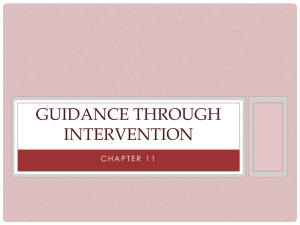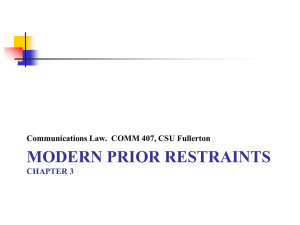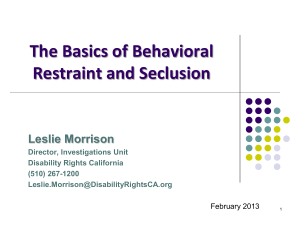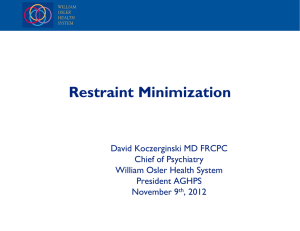Agenda Item 9 iii ) MIND Report
advertisement
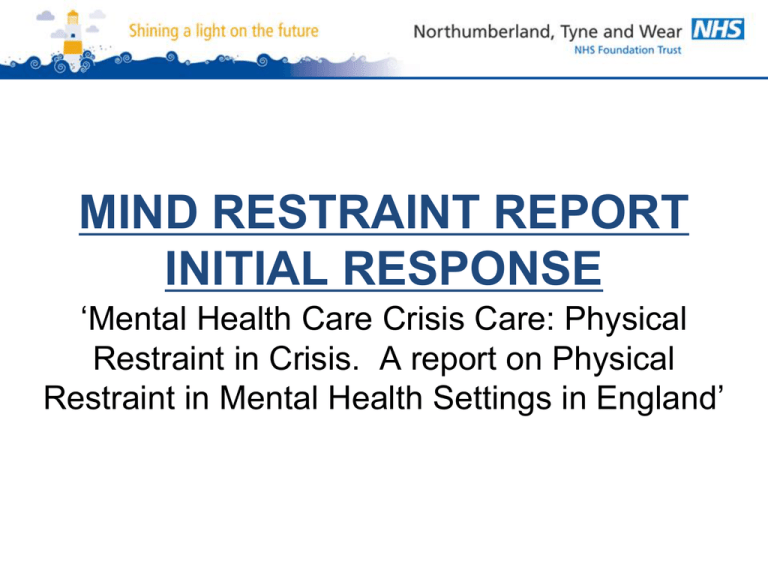
MIND RESTRAINT REPORT INITIAL RESPONSE ‘Mental Health Care Crisis Care: Physical Restraint in Crisis. A report on Physical Restraint in Mental Health Settings in England’ Background • On the 19th June 2013 MIND published a report ‘Mental health crisis care: physical restraint in crisis. A report on physical restraint in hospital settings in England’. • The report focused on the use of physical restraint in mental health settings in England and attracted significant local and national media attention, particularly in relation to the use of the prone restraint position (face down). • The data contained within the report was gathered by a Freedom of Information (FOI) request in February 2013 to all 54 Mental Health Trusts in England. The FOI request asked for a response to nine questions: Nine Questions Asked in the FOI Request 1. Total number of incidents of physical restraint by one or more members of staff 2. Total number of patients who experienced physical restraint by one or more members of staff 3. Total number of incidents of face down physical restraint by one or more members of staff 4. Total number of incidents where physical restraint was used to administer medication 5. Total number of incidents where police were involved in physically restraining a patient 6. Total number of incidents of physical injury following physical restraint 7. Total number of incidents of psychological harm following physical restraint 8. Total number of incidents of physical restraint resulting in death 9. Total number of complaints received following physical restraint Highlights It is important to note that there was significant variation in terms of the number of Trust responses and the data completeness of those responses. This makes it extremely difficult to draw any solid conclusions from the data. • 47 (87%) of trust’s provided information on the total number of incidents of restraint. • Only 27 (50%) trust’s provided information on the number of prone restraints (NTW reported the highest number 923). • Only 31 (57%) gave information on restraint and medication. • Only 27 (50%) gave information on police called / involved. • Only 34 (62%) gave information on injuries. • 14 (25%) gave information on psychological harm. • No deaths – 36 injuries all of which were minor. • We know at least two of the four trusts highlighted as not using face down still do. Rationale • • • • • We are one of the largest mental health and disability trusts in the country, covering two large cities in the North East, as well as providing both regional and national specialist services. However our figures are comparable to other mental health trusts of similar size and who also provide a similar range of regional and national specialist services. Due to the specialist nature of a number of our services such as our forensic services, the trust cares for some of the most complex and challenging patients from all over the country, which means that the figures may be higher when comparing us to other trusts without such specialist services. Analysis of our figures has shown that a small group of less than 50 patients, who demonstrate very complex and high risk behaviours account for over two thirds of all the recorded incidents of restraint. The Trust is an open and transparent organisation with a strong culture of reporting all episodes of restraint, regardless of type. Data Return Incidents of physical restraint Patients experiencing physical restraint Incidents of face down restraint Incidents of physical restraint resulting in physical injury Complaints relating to physical restraint Declared total staff Population TEWV 3346 398 Not provided 1 0 5839 1,400,000 Lancashire 3018 851 Not provided 200 7 8130 872,400 Southern Health 3003 3133 810 Not provided 0 7691 770,200 NTW 2660 384 923 36 2 6709 1,400,000 Birmingham & Solihull 2043 251 Not provided 14 4 4480 765,200 Leeds and York 1525 328 65 78 1 4854 702,900 South West Yorkshire 1251 Not provided 117 3 1 6550 713,900 Central and North West London 914 Not provided Not provided 4 4 5899 780,600 Oxford 778 287 225 Not provided 0 5979 401,800 North East London 84 56 Not provided 3 3 6153 568,100 Injury Data Incidents of physical restraint Incidents of physical restraint resulting in physical injury Percentage 5 Boroughs 1415 169 11.9% Cheshire & Wirral 1538 88 5.7% Dorset 568 35 6.1% Dudley and Walsall 121 19 15.7% Humber 334 23 6.8% Lancashire 3018 200 6.6% Leeds and York 1525 78 5.1% Mersey Care 1347 94 6.9% NTW 2660 36 1.3% South Essex 833 56 6.7% Sussex 247 17 6.8% Use of Restraint • The use of physical restraint in any of our services setting is always used as the last resort after all other options have been exhausted. • The vast majority of situations are successfully resolved safely through effective staff engagement, communication and deescalation skills. • Most restraints do not involve the use of the prone (face down) position. • Restraint techniques include the standing, sitting, supine (face up) and prone position, with the prone position used only as an absolute last resort and for the shortest possible time. • The use of any restraint is continually risk assessed on an individual and on-going basis with the safest and most proportionate response used. • Most incidents are resolved within minutes. Use of Restraint • The techniques are not designed to cause pain and have been independently medically risk assessed. • These types of techniques are used by the vast majority of mental health and disability NHS trusts and they are in line with current best practice and national guidance. • Our staff are given extensive training in recognition, prevention and de-escalation skills as well as methods of physical restraint and the risks associated with the use of physical restraint to ensure that they can manage episodes of violence and aggression in a safe, supportive, dignified and professional manner in line with national guidance and the best available evidence. • The trust is part of a national best practice association GSA • The trust has been asked to take a leading national role in PMVA Action Plan • • • Establish a Task and Finish Group with clear Terms of Reference to review the use of physical restraint across the Trust. Led by the Executive Director of Nursing and Operations membership of the group will include: Group Nurse Directors; Clinical Director, Forensic Service; Clinical Director, Children and Young Peoples Service; Directorate Manager, Stepped Care; Chair of the Trust MVA Group; Head of Training; two MVA Trainers; Nurse Consultants from the Specialist Care Group; Deputy Director of Clinical Governance; Head of Safety; Head of Safeguarding Children; Director of Clinical Effectiveness; Patient Safety Manager; and external experts as required. Undertake a peer review of the care records of those patients who were restrained in the prone position. The Terms of Reference will set out clearly the areas to be reviewed and the expertise required. Review the Trust’s MVA training programmes to ensure they are underpinned by best available evidence and current national guidelines. Action Plan • • • • • • Review the Trust Prevention and Management of Violence and Aggression policy and PGNs to ensure they are in line with best available evidence and in line with current national guidance. Undertake an extensive literature review to inform actions 3 and 4. Undertake a full review of the Trust’s reporting process in relation to the Prevention and Management of violence and aggression. The Task and Finish Group will identify and co-ordinate examples of good practice from other organisations to support and inform this review. Provide regular updates to the Board of Directors, Senior Management Team, and the wider organisation. Complete all actions within six months with a final report with recommendations to the Senior Management Team and Board of Directors. Response from a Carer I’ve read this morning on the BBC site about face down restraint and the high figures in NTW trust – I’m fairly certain that some of those figures include X, and though not used recently has been used in the past. Obviously Restraint of X is a matter for the MDT involved in X’s care however could I say I support the use of “face down” - to me (as an engineer ) legs and arms naturally bend forwards so if you want to stop them working then put a block (ie the floor) in front of him if you were to use face up restraint then the block will have to be people and staff and you would probably have to use more and stronger tactics to restrain rather than less and have a greater risk of injury to staff and X. The best restraint is to never have to use one at all - that is done by environment and behavioural modification – something that the Unit has done with great expertise, but the staff (and X) need the protection of the sanction of restraint when absolutely required and to me the best restraint to use is one that will immobilize X with the minimal amount of people and the minimal amount of time with the minimal risk of injury to staff and X. I have no doubt at all that this view is shared by the MDT team and of course they should decide the method. I have said in the past that I would find it extremely difficult to approve restraint or medication for X but I wholeheartedly agree with its use. I am forever grateful for the Consultants in charge for taking and making the decision and the protection that the MHA gives. However if you are reviewing restraint based on this reporting I would ask that you consider my views as one of support for restraint. Please all keep up the good work, I hope that face down restraint is never used on X again, but I hope it is for the right reasons – that X doesn’t need restraint. However I would wholeheartedly support the Unit in any restraint they feel they need to use including face down which to me as a bystander seems to be the most sensible method of immobilising head, arms and legs as you are stopping them from moving in their natural direction very easily. X is my son, I want to see the minimal pain and suffering for him and I am convinced the staff do also, however staff need and deserve the best protection that they can be given, the report seems to be sadly missing this fact. I am completely happy for this to be shared amongst staff members if you wish so that they know they have my absolute support in any restraint they use Names removed to protect patient confidentiality Questions

